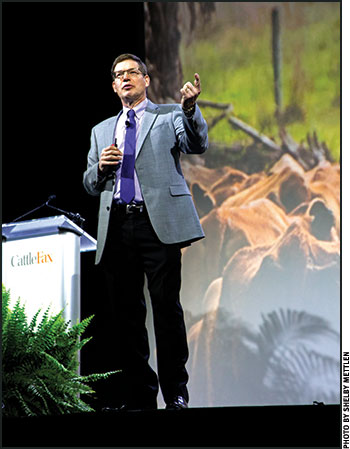Cattle Market Predictions
CattleFax analyst outlines his thoughts on the 2017 market.

Beef cattle production was up 14%, but at a level that suggests the herd is still expanding, Kevin Good explained. Total cattle inventories in the United States have increased nearly 5 million head in three years, totaling 93.4 million head in 2017. The country’s beef cow inventory has grown to 2.2 million head in three years, and an additional 400,000 head are expected to be added to that inventory in the next two years.
Beef production was up 1.5 million pounds (lb.) year-over-year last year, Kevin Good told his audience at the National Cattlemen’s Beef Association (NCBA) Cattle Industry Convention in Nashville, Tenn., on Feb. 2. With poultry and pork production added in, that number increased to 3 million lb. Good, a senior analyst with CattleFax, addressed the audience at Thursday’s opening session.
Expansion
Beef cattle production was up 14%, but at a level that suggests the herd is still expanding, Good explained. Total cattle inventories in the United States have increased nearly 5 million head in three years, totaling 93.4 million head in 2017.
The country’s beef cow inventory has grown to 2.2 million head in three years, and an additional 400,000 head are expected to be added to that inventory in the next two years.
Good reminded the audience that it’s important to note this expansion is largely due to herd rebuilding after the extreme drought in the Southern Plains. Texas added 550,000 head; Oklahoma added 300,000 head; and Kansas added 150,000 head.
Fed cattle
Dairy-based cattle in feedyards peaked in 2015 and 2016 at nearly 20%. Calf slaughter is expected to be up 100,000 head this year, as dairy calves are slaughtered earlier and feedlots turn back toward beef breeds because of their yield and quality potential, Good said.
“We’ve got a calf market this year that we think will remain stout enough to be profitable for the average cow-calf producer,” Good said. Lower input costs and favorable feed conditions will contribute to this. He also pointed out that grain costs will be lower in 2017, leading to cheaper feeding costs.
Feedlots will continue to turn over inventory quickly, and heifer placement will increase, predicted Good. Fed-cattle slaughter is expected to reach 25.5 million head in 2017.
Seasonality of supply
After last year’s rare peak in slaughter in November 2016, Good said, “Fed-cattle supplies are at the tightest point today — and over the next 30 to 45 days — that they’ll be at any time this year as we think about it from a cycle standpoint — at any time we’ll see over probably the next five to six years.”
He predicted in the second half of this year slaughter will reach 95,000 head on a daily basis. Packer profits were good last year and will continue to be favorable in 2017.
Leverage
Greater supplies will result in lower prices going forward, Good noted. Demand will determine the magnitude of the downtrend. Demand for beef is estimated to decrease 5% in 2016 due to lower pork and chicken prices.
Good said carcass weights will be down this year, noting that when cattle numbers are expanding, carcass weights tend to plateau. He said he expects that to happen during the next couple of years.
Good estimated fed-cattle price will be small in 2017, but said the lowest point was last October. “Will it stay low?” he asked. “Yes, because of the leverage component.”
The market structure today is so much better than it was a year ago at the same time, he said. “Cattle are making money.”
Trade will continue to be important, as one out of every 4 lb. of increased production in the United States will be exported. “Export markets are a plus,” he noted.
Protein outlook
Protein retail prices have all decreased since 2014, but “there are positives,” Good said. Poultry has been declining for three years, pork for a little more than two years, and beef just a little more than a year.
In 2005 and 2006, the industry produced 1.5 lb. of Choice beef for every 1 lb. of Select. Last year, it produced 3.7 lb. of Choice for every 1 lb. of Select. The Choice-Select spread was $3 wider last year.
“One of the things we can look back at and say ‘we did a good job,’ ” Good said, “is improving our product.”
Good predicted a move into bigger supplies. “We suggest the market is starting to stretch the top end of the range,” he said.

Editor’s Note: This article was written as part of Angus Media’s coverage of the 2017 Cattle Industry Convention. For further coverage watch for the March Angus Beef Bulletin and visit Angus Media online at www.angus.media.






